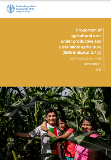Accelerate > Publications
Search this online library featuring the latest FAO publications, issue papers and briefs which offer up-to-date knowledge and innovative insights for SDG acceleration.
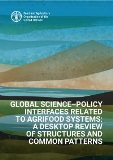
Global science–policy interfaces related to agrifood systems: a desktop review of structures and common patterns
2024
This background paper to the guidance that FAO is developing on strengthening science–policy interfaces (SPIs) for agrifood systems at the national level sets provides information about the structures and patterns common to global SPIs.

Water stress plugin for Water Evaluation and Planning system (WEAP): Using the water evaluation and planning tool for the calculation of Sustainable Development Goal indicator 6.4.2
2024
This report presents the instruction manual of the new water stress plugin developed by FAO in collaboration with the Stockholm Environment Institute's U.S. Center (SEI) for the calculation of the SDG indicator 6.4.2 “Level of water stress: freshwater withdrawal as a proportion of available freshwater resources” by river basin.

Tackling antimicrobial resistance in food and agriculture
2024
The Food and Agriculture Organization of the United Nations (FAO) leads the global response to antimicrobial resistance (AMR) in the food and agriculture sectors. Its work in response to the many challenges of AMR is currently guided by the FAO Action Plan on Antimicrobial Resistance 2021–2025. This first report on FAO’s contribution to the global response to AMR outlines a wide range of activities undertaken by FAO at global, regional and country level.
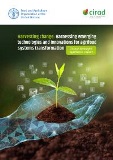
Harvesting change: Harnessing emerging technologies and innovations for agrifood system transformation - Global foresight synthesis report
2023
This study assesses a selection of technologies and innovations, which potentially could be of paramount importance in addressing agrifood challenges until 2050, as well as the most important trends and drivers that will influence the emergence of agrifood technologies and innovations and their triggers of change, including some regional aspects.
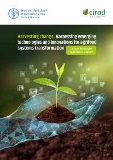
Harvesting change: Harnessing emerging technologies and innovations for agrifood system transformation
2023
The study assesses a selection of technologies and innovations, which potentially could be of paramount importance in addressing agrifood challenges until 2050, as well as the most important trends and drivers that will influence the emergence of agrifood technologies and innovations and their triggers of change, including some regional aspects. The goal is also to build plausible future scenarios for the evolvement of the emerging technologies and innovations in the future with the time...

FAO and the 2030 Agenda Follow-up and Review: Guidance Note for Regional and Country Offices
2023
The Guidance Note describes the process of the preparation of the VNRs and what FAO Regional and Country Offices need to be aware and mindful of when providing support to the national partners. It covers information about the importance of the follow-up and review process for the 2030 Agenda and the SDGs, including information about the gaps in the coverage of the Voluntary National Reviews, and recommendations on strengthening VNRs to be meaningful instruments for the acceleration of the SDGs.

Sustainable livestock transformation. A vision for FAO’s work on animal production and health
2023
Within the framework of the United Nations 2030 Agenda for Sustainable Development, FAO assists Member Nations to improve sound policies, increase investments and develop good practices in the livestock sector.
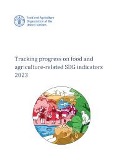
Tracking progress on food and agriculture-related SDG indicators 2023
2023
At the mid-point of the Agenda 2030 for Sustainable Development, there is an urgent need to understand where the world stands in eliminating hunger and food insecurity, as well as in ensuring sustainable agriculture. The new report of the Food and Agriculture Organization of the United Nations (FAO),offers analysis and trends on indicators across eight Sustainable Development Goals (SDGs) – in particular, SDGs 1, 2, 5, 6, 10, 12, 14 and 15.
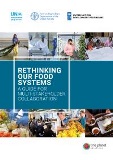
Rethinking our food systems: A guide for multi-stakeholder collaboration
2023
This guide aims to support stakeholders working at all levels of the food system in the implementation of actions to transform their food systems. Centered on 5 building blocks underpinning successful multi-stakeholder collaboration for food systems transformation, the guide uses these constructions to illustrate ingredients of the process and show the interconnectedness of the steps needed to be successful.

2023 SDG Summit: FAO Key Messages
2023
The 2023 SDG Summit will serve as a pivotal event towards achieving the SDGs, as gathered Heads of State and Government are to carry out a comprehensive review of progress, respond to the impact of multiple crises, and provide high-level political guidance on transformative and accelerated actions for achieving the 2030 Agenda. FAO has developed these key messages to inform the discussions in the lead up to and during this Summit and the Political Declaration which will result from them.
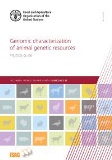
Genomic characterization of animal genetic resources - Practical guide
2023
Molecular biotechnologies have developed rapidly and substantially since the release of these previous guidelines. The livestock sector has been an active participant in the so-called “genomic revolution.” Advancements in the sequencing of genomes and related genotyping methods have created opportunities for gathering much more information on the molecular level than ever possible, at a faster rate, and for exponentially decreased costs.
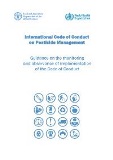
International Code of Conduct on Pesticide Management - Guidance on the monitoring and observance of implementation of the Code of Conduct
2023
The objective of this guidance on fulfilling the reporting requirements of Article 12 of the Code of Conduct is to obtain a regular flow of information on its observance to strengthen implementation of the Code, to provide data for its future revisions and improvement, and, most importantly, to improve the protection of human health and the environment related to pesticide use and management in agriculture and public health.
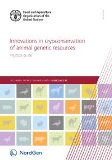
Innovations in cryoconservation of animal genetic resources - Practical guide
2023
The livestock sector faces a range of challenges, including climate change, emerging diseases, competition for natural resources and evolving demand for animal-source foods, which is increasing globally, especially in developing countries. Genetic diversity of livestock is a key resource for allowing livestock keepers to address these challenges, but this diversity has been in a state of decline...

Progress on the level of water stress. Global status and acceleration needs for SDG indicator 6.4.2, 2021
2023
The global indicator on water stress tracks the level of pressure that human activities exert over natural freshwater resources, indicating the environmental sustainability of the use of water resources. A high level of water stress has negative effects on social and economic development, increasing competition and potential conflict among users. This report is part of a series that tracks progress towards the various targets set out in SDG 6 using the SDG global indicators.
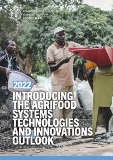
Introducing the Agrifood Systems Technologies and Innovations Outlook
2022
Agrifood system transformation to achieve the Sustainable Development Goals requires increased attention to developing, adapting and diffusing impactful science, technology and innovation (STI). Current levels and patterns of STI uptake are inadequate to facilitate needed agrifood system transformations, especially in today's low- and middle-income countries
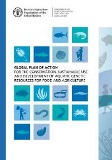
Global Plan of Action for the Conservation, Sustainable Use and Development of Aquatic Genetic Resources for Food and Agriculture
2022
This Global Plan of Action for the Conservation, Sustainable Use and Development of Aquatic Genetic Resources for Food and Agriculture (GPA) was developed by FAO at the request of the members of the Commission on Genetic Resources for Food and Agriculture in response to the needs and challenges identified in the first global assessment of the status of Aquatic Genetic Resources for Food and Agriculture (AqGR).
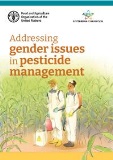
Addressing gender issues in pesticide management
2022
The Rotterdam Convention Secretariat (NSPRD) and the Gender team in ESP developed this publication with the objective of highlighting the gender-related implication of pesticide use and management, focusing on the role of women in handling hazardous pesticides in agriculture, the reasons why they are at higher risk and the health-related implications they face. The brochure provides an overview of how FAO addresses the topic ...
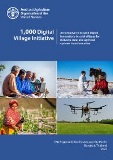
1,000 Digital Village Initiative - An initiative to expand digital innovations in rural villages for inclusive rural and agrifood systems transformation
2022
This report introduces the FAO Digital Village Initiative, which aims to facilitate through knowledge and information. It approaches countries and communities to develop, accelerate and deploy digital technologies in rural villages and communities. The report introduces the Digital Village Ecosystem approach. It describes an instrument (tool) to gather information and provide a village ecosystem assessment to help generate recommendations for future interventions to deploy beneficial, ...

Transforming public agricultural extension and advisory service systems in smallholder farming - Status quo, gaps, way forward
2022
Worldwide, extension and advisory service (EAS) systems have undergone reforms since the 1990s. However, the reforms of the last two decades in many countries have largely failed, as there has not been significant increase in accountability, efficiency, empowerment or impact. To fill this gap, this document, based on a systematic and extended literature review, delves into public EAS systems in developing countries, with a special focus on smallholder farming and institutional reforms.
Browse by SDG
- SDG1: No Poverty
- SDG2: Zero Hunger
- SDG3: Good Health & Well-being
- SDG4: Quality Education
- SDG5: Gender Equality
- SDG6: Clean Water & Sanitation
- SDG7: Affordable and Clean Energy
- SDG8: Decent Work and Economic Growth
- SDG9: Industry, Innovation and Infrastructure
- SDG10: Reduced Inequalities
- SDG11: Sustainable Cities and Communities
- SDG12: Responsible Consumption and Production
- SDG13: Climate Action
- SDG14: Life Below Water
- SDG15: Life on Land
- SDG16: Peace, Justice and Strong Institutions
- SDG17: Partnerships for the Goals
Browse by Better
Browse by Priority Area
- Innovation for Sustainable Agriculture Production
- Blue Transformation
- One Health
- Small-Scale Producers' Equitable Access to Resources
- Digital Agriculture
- Healthy Diets for All
- Nutrition for the Most Vulnerable
- Safe Food for Everyone
- Reducing Food Loss and Waste
- Transparent Markets and Trade
- Climate Change Mitigating and Adapted Agrifood Systems
- Bioeconomy for Sustainable Food and Agriculture
- Biodiversity and Ecosystem Services for Food and Agriculture
- Achieving Sustainable Urban Food Systems
- Gender Equality and Rural Women's Empowerment
- Inclusive Rural Transformation
- Agriculture and Food Emergencies
- Resilient Agrifood Systems
- Hand-in-Hand Initiative
- Scaling up Investment

